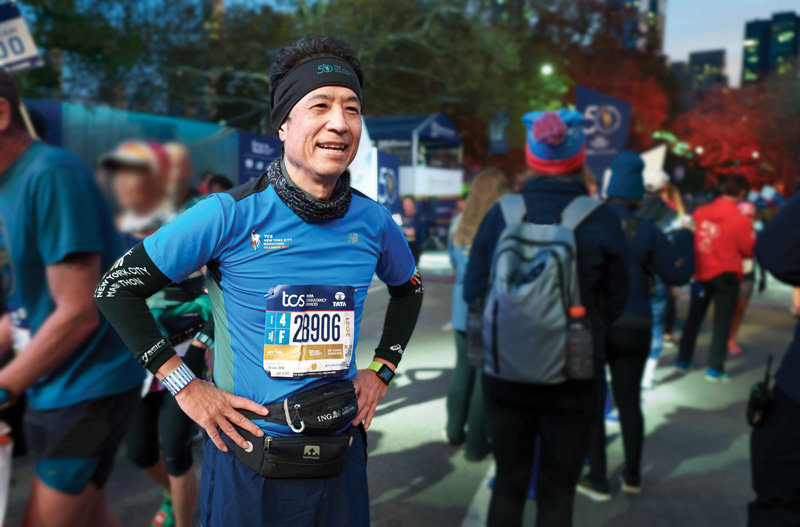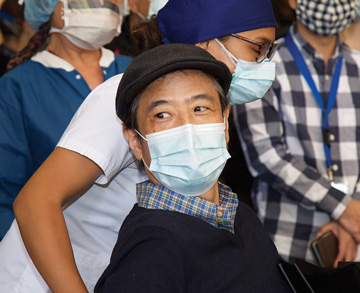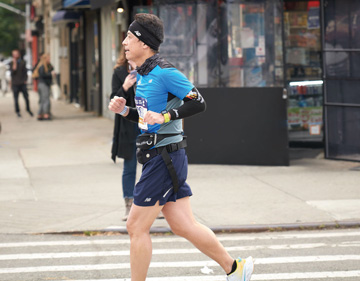On March 25, Dr. Kato was admitted to NewYork-Presbyterian/Columbia’s emergency room, where he was administered oxygen. His colleagues shared their reflections of that trying time with NewYork-Presbyterian’s Health Matters.
“We knew Tom was home and not feeling great,” says Craig R. Smith Jr., MD, the medical center’s surgeon-in-chief. “The next thing we know he’s struggling in the ER.”
Dr. Kato’s condition continued to deteriorate. “Overnight it was clear things were progressing in the worst way,” says Marcus Pereira, MD, medical director of the transplant infectious diseases program at NewYork-Presbyterian/Columbia.
“When we first laid eyes on him, it was shocking because he looked much sicker than what we anticipated. He was breathing very fast and looked exhausted. By the next morning, his oxygen requirement kept going up.”
Dr. Kato was transferred to the intensive care unit. The colleagues he worked alongside to save the lives of countless patients were now collaborating to save his. “That was during the peak of the pandemic, when you cried on your way
home because there was so much badness going on that we couldn’t stop,” says Joshua Sonett, MD, the medical center’s chief of general thoracic surgery. “Knowing that one of our own was critically ill made it more
personal.”
When Dr. Kato was told he would have to be intubated, he still wasn’t overly concerned about his own well-being — perhaps because of the euphoria caused by his hypoxic state — and even texted his good friend Gebhard Wagener,
MD, asking him to perform the intubation. “At that moment, my heart sank because it became extraordinarily real that he was so sick,” says Dr. Wagener, director of vascular anesthesia at NewYork-Presbyterian/Columbia.
While he was intubated, Dr. Kato experienced horrific hallucinations and vivid nightmares that haunt him to this day. In some, he was receiving care in frightening hospitals around the world, screaming to his providers to let him go home.
He remembers being surrounded by a bright white light. He thought he had died.
Dr. Kato was placed on a ventilator for nine days before his condition deteriorated further. He was teetering on multi-organ failure and nearly died several times. His colleagues and friends huddled in the hallway outside his room, fretting
about his chances of survival. As a last resort, they decided to put him on ECMO, an extracorporeal membrane oxygenation machine that pumps blood and oxygen through the body and removes carbon dioxide. His chance of surviving was 10%,
according to Dr. Smith.
Dr. Kato had become one of the sickest patients in his own hospital. His physicians discovered he had superimposed bacterial pneumonia — bacteria growing in his bloodstream, which was treated with antibiotics. It was only then that he
showed the first signs of what would be a slow and gradual recovery.
About four weeks after being intubated, Dr. Kato began to emerge from his unconsciousness. However, he remained confused and agitated after coming off the ventilator, and concerns grew that he had suffered brain damage. He moved to the hospital’s
neurological intensive care unit, where doctors found and treated a minor blood clot in his brain.
Soon after he awoke to sun streaming through the window of his hospital room. Dr. Kato saw the Hudson River below and the George Washington Bridge in the distance. A nurse was sitting by his side. He asked him, “Am I in New York?”
“New York? You’ve always been in New York,” replied the nurse.
“That’s when things began to make some sense again,” says Dr. Kato.
Still, a long road of recovery lay ahead. Dr. Kato lost about 25 pounds and nearly all his muscle strength. He was on dialysis, had several IVs placed and required a nasogastric tube to receive nutrients.
On April 27, Dr. Kato was transferred to the medical center’s acute rehab unit, where he would begin a grueling regimen to regain his strength. He first learned to hold himself up on handrails before gradually building up the endurance
to walk on his own. Finally, a month later, Dr. Kato was ready to go home.
“Kat-to! Ka-to! Ka-to!” The cheers echoed through the lobby of NewYork-Presbyterian as more than 200 of the hospital’s workers surrounded Dr. Kato’s wheelchair as he was discharged on May 26, nine weeks after
being admitted. He’s a beloved physician, a kind soul who would do anything for his colleagues and patients. “The hospital celebrates when all COVID patients leave. I knew there would be a celebration, but I didn’t know
it would be that big,” says Dr. Kato. “It was an emotional moment, and I truly appreciated everyone who played a part in curing me. I survived because of their hard work.”
It was an emotional moment, and I truly appreciated everyone who played a part in curing me.
— Tomoaki Kato, MD, MBA, FACS
Dr. Kato beat COVID-19 during the first wave of the pandemic, when little was known about how to protect the nation from the spreading virus and the best ways to treat infected patients. “My sickness was a scare for everybody,”
says Dr. Kato. “Healthcare providers knew what COVID was, but didn’t fully believe they could be at risk of dying. They faced a constant threat of getting COVID and fought through their fears to do their jobs. To see me get
back to normal was a celebration for my journey, and a celebration for everyone else who worked in the hospital.”
As Dr. Kato was being wheeled out of the hospital, he thought about the day he’d walk back in to care for patients. Questions remained about whether he’d regain the physical strength to endure and perform grueling transplant surgeries,
which can last for 10 hours. He lacked nerve function in his shoulder, and couldn’t raise his arms as a result, but it eventually returned about a month after his discharge.
After several months of physical therapy, Dr. Kato returned to the OR in August to perform a robotic hernia repair. It’s a relatively straightforward procedure that requires little physical strain. He sat at the console, placed his hands
on the controls and began to operate as several colleagues gathered outside the room to watch.
“That was really a moment,” he says. “I was nervous, to be honest, but as soon as I began the case, my skills and coordination came back quickly. It was a big relief.”
Dr. Kato slowly ramped up his workload between September and December, nearly reaching his typical caseload of transplant procedures by the end of the year. When his body could once again endure the rigors of those marathon surgeries, he began
to believe he could complete one more comeback.
.svg?sfvrsn=be606e78_3)



.svg?sfvrsn=56b2f850_5)